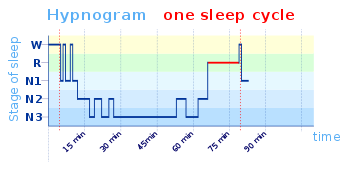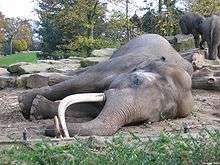Sleep cycle
The sleep cycle is an oscillation between the slow-wave and REM (paradoxical) phases of sleep. It is sometimes called the ultradian sleep cycle, sleep–dream cycle, or REM-NREM cycle, to distinguish it from the circadian alternation between sleep and wakefulness. In humans this cycle takes 1–2 hours.

Characteristics
Electroencephalography shows the timing of sleep cycles by virtue of the marked distinction in brainwaves manifested during REM and non-REM sleep. Delta wave activity, correlating with slow-wave (deep) sleep, in particular shows regular oscillations throughout a good night's sleep. Secretions of various hormones, including renin, growth hormone, and prolactin, correlate positively with delta-wave activity, while secretion of thyroid-stimulating hormone correlates inversely.[1] Heart rate variability, well-known to increase during REM, predictably also correlates inversely with delta-wave oscillations over the ~90-minute cycle.[2]
In order to determine in which stage of sleep the asleep subject is, electroencephalography is combined with other devices used for this differentiation. EMG (electromyography) is a crucial method to distinguish between sleep phases: for example, in general, a decrease of muscle tone is characteristic of the transition from wake to sleep (Kleitman, 1963;[3] Chase & Morales, 1990[4]), and during REM sleep there is a state of muscles atonia, resulting in an absence of signals in the EMG.[4]
EOG (electrooculography), the measure of the eyes’ movement, is the third method used in the sleep architecture measurement;[5] for example, REM sleep, as the name indicates, is characterized by a rapid eye movement pattern, visible thanks to the EOG.[6]
Moreover, methods based on cardiorespiratry parameters are also effective in the analysis of sleep architecture, if they are associated the other aforementioned measurements (such as electroencephalography, electrooculography and the electromyography).[7]
Homeostatic functions, especially thermoregulation, occur normally during non-REM sleep, but not during REM sleep. Thus, during REM sleep, body temperature tends to drift away from its mean level, and during non-REM sleep, to return to normal. Alternation between the stages therefore maintains body temperature within an acceptable range.[8]
In humans the transition between non-REM and REM is abrupt; in other animals, less so.[9]
Researchers have proposed different models to elucidate the undoubtedly complex rhythm of electrochemical processes that result in the regular alternation of REM and NREM sleep. Monoamines are active during NREMS but not REMS, whereas acetylcholine is more active during REMS. The reciprocal interaction model proposed in the 1970s suggested a cyclic give and take between these two systems. More recent theories such as the "flip-flop" model proposed in the 2000s include the regulatory role of in inhibitory neurotransmitter gamma-aminobutyric acid (GABA).[10]
Length

The standard figure given for the average length of the sleep cycle in an adult man is 90 minutes. N1 (NREM stage 1) is when the person is drowsy or awake to falling asleep. Brain waves and muscle activity start to decrease at this stage. N2 is when the person experiences a light sleep. Eye movement has stopped by this time. Brain wave frequency and muscle tonus is decreased. The heart rate and body temperature goes down. N3 or even N4 are the most difficult stages to be awakened. Every part of the body is now relaxed, breathing, blood pressure and body temperature are reduced. The National Sleep Foundation discusses the different stages of NREM sleep and their importance. They describe REM sleep as "A unique state, in which dreams usually occur. The brain is awake and body paralyzed." This unique stage is usually when the person is in the deepest stage of sleep and dreams.[11][9] The figure of 90 minutes for the average length of a sleep cycle was popularized by Nathaniel Kleitman around 1963.[12] Other sources give 90–110 minutes[1] or 80–120 minutes.[2]

In infants the sleep cycle lasts about 50–60 minutes; average length increases as the human grows into adulthood. In cats the sleep cycle lasts about 30 minutes, in rats about 12 minutes, and in elephants up to 120 minutes. (In this regard the ontogeny of the sleep cycle appears proportionate with metabolic processes, which vary in proportion with organism size. However, shorter sleep cycles detected in some elephants complicate this theory.)[9][11][13]
The cycle can be defined as lasting from the end of one REM period to the end of the next,[11] or from the beginning of REM, or from the beginning of non-REM stage 2. (The decision of how to mark the periods makes a difference for research purposes because of the unavoidable inclusion or exclusion of the night's first NREM or its final REM phase if directly preceding awakening.)[12]
A 7–8-hour sleep probably includes five cycles, the middle two of which tend to be longer than the first and fourth.[12] REM takes up more of the cycle as the night goes on.[9][14]
Awakening
Unprovoked awakening occurs most commonly during or after a period of REM sleep, as body temperature is rising.[15]
Continuation during wakefulness
Ernest Hartmann found in 1968 that humans seem to continue a roughly 90-minute ultradian rhythm throughout a 24-hour day, whether they are asleep or awake.[11] According to this hypothesis, during the period of this cycle corresponding with REM, people tend to daydream more and show less muscle tone.[16] Kleitman and others following have referred to this rhythm as the basic rest–activity cycle, of which the "sleep cycle" would be a manifestation.[12][17] A difficulty for this theory is the fact that a long non-REM phase almost always precedes REM, regardless of when in the cycle a person falls asleep.[12]
Alteration
The sleep cycle has proven resistant to systematic alteration by drugs. Although some drugs shorten REM periods, they do not abolish the underlying rhythm. Deliberate REM deprivation shortens the cycle temporarily, as the brain moves into REM sleep more readily (the "REM rebound") in an apparent correction for the deprivation.[11]
Michel Jouvet found that cats with forebrains removed continued to display REM-like characteristics on a 30-minute cycle, despite never entering slow-wave sleep.[11]
References
- Claude Gronfier, Chantal Simon, François Piquard, Jean Ehrhart, & Gabrielle Brandenberger, "Neuroendocrine Processes Underlying Ultradian Sleep Regulation in Man", Journal of Clinical Endocrinology & Metabolism 84(8), 1999; doi:10.1210/jcem.84.8.5893.
- Gabrielle Brandenberger, Jean Erhart, François Piquard, & Chantal Simon, "Inverse coupling between ultradian oscillations in delta wave activity and heart rate variability during sleep"; Clinical Neurophysiology 112(6), 2001; doi:10.1016/S1388-2457(01)00507-7.
- Kleitman, N. (1963). Sleep and Wakefulness Chicago, Univ. Chicago Jfress
- Chase, M. H., & Morales, F. R. (1990). The atonia and myoclonia of active (REM) sleep. Annual review of psychology, 41(1), 557-584.
- Berry, R. B., & Wagner, M. H. (2014). Sleep Medicine Pearls E-Book. Elsevier Health Sciences.
- ber C., Ancoli-Israel S., Chesson A., and Quan SF. in The AASM Manual for the Scoring of Sleep and Associated Events: Rules, Terminology and Technical Specifications, 1st. Ed.: Westchester, Illinois: American Academy of Sleep Medicine; 2007.
- Tataraidze, A., Korostovtseva, L., Anishchenko, L., Bochkarev, M., & Sviryaev, Y. (2016,). Sleep architecture measurement based on cardiorespiratory parameters.
- Pier Luigi Parmeggiani, "Modulation of body core temperature in NREM sleep and REM sleep"; in Mallick et al. (2011).
- Robert W. McCarley, "Neurobiology of REM and NREM sleep"; Sleep Medicine 8, June 2007; doi:10.1016/j.sleep.2007.03.005.
- James T. McKenna, Lichao Chen, & Robert McCarley, "Neuronal models of REM-sleep control: evolving concepts"; in Mallick et al. (2011).
- Hartmann, Ernest (March 1968). "The 90-Minute Sleep-Dream Cycle". Archives of General Psychiatry. 18 (3): 280–6. doi:10.1001/archpsyc.1968.01740030024004. PMID 5638533.
- I. Feinberg & T. C. Floyd, "Systematic Trends Across the Night in Human Sleep Cycles"; Psychophysiology 16(3), 1979; doi:10.1111/j.1469-8986.1979.tb02991.x.
- Irene Tobler, "Behavioral sleep in the Asian elephant in captivity"; Sleep 15(1), 1992; PMID 1557589.
- Daniel Aeschbach, "REM-sleep regulation: circadian, homeostatic, and non-REM sleep-dependent determinants"; in Mallick et al. (2011).
- Torbjorn Åkerstedt, Michel Billiard, Michael Bonnet, Gianluca Ficca, Lucile Garma, Maurizio Mariotti, Piero Salzarulo, & Hartmut Schulz. "Awakening from sleep", Sleep Medicine Reviews 6(4), 2002; doi:10.1053/smrv.2001.0202.
- Ekkehard Othmer, Mary P. Hayden, and Robert Segelbaum, "Encephalic Cycles during Sleep and Wakefulness in Humans: a 24-Hour Pattern" (JSTOR); Science 164(3878), 25 April 1969.
- Nathaniel Kleitman, "Basic Rest-Activity Cycle—22 Years Later"; Sleep 5(4), 1982; doi:10.1093/sleep/5.4.311.
Bibliography
- Mallick, B. N.; S. R. Pandi-Perumal; Robert W. McCarley; and Adrian R. Morrison (2011). Rapid Eye Movement Sleep: Regulation and Function. Cambridge University Press. ISBN 978-0-521-11680-0
- Nir, and Tononi, "Dreaming and the Brain: from Phenomenology to Neurophsiology." Trends in Cognitive Sciences, vol. 14, no. 2, 2010, pp. 88–100.
- Varela, F., Engel, J., Wallace, B., & Thupten Jinpa. (1997). Sleeping, dreaming, and dying: An exploration of consciousness with the Dalai Lama.